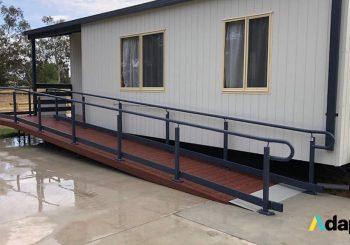Ramps are not something new.
People have used ramps for hundreds of years. You can define a ramp as a flat board placed on an angle. But such a ramp may be too steep, lack handrails, toe guards and textured surfaces. Users can easily fall and harm themselves while using such surfaces.
Anyone going up a ramp must be able to do it with ease regardless of the mobility device they are using. So, ramp builders follow guidelines on the degree of the pitch of a ramp. If you are walking up the ramp, a 4.8° slope with stopping points for different lengths is considered normal, while for an electronic device a steeper slope is fine. A ramp must be safe to move up or down. Here are some common ramp installation myths:
#1 A Ramp Is A Piece Of Plywood
Yes and no. Plainly speaking, a piece of plywood can be converted into a ramp. But, plywood is pretty slippery when it becomes wet. It also swells affecting the integrity of bonds between the laminates, and it isn’t a suitable material for ramp construction. We make resilient ramps using the best quality materials. Our prefabricated products are coated so that their seamless and no-weld installation can withstand the elements.
#2 A Steep Ramp Is Fine
If someone has told you that you do not need a long ramp, that is a fallacy. When you settle for a ramp that is no longer than your stairs, you are inviting some injury or disaster. DDA guidelines require that you maintain a ratio of one inch of a rise to 12 inches or one foot of ramp run. Convert it into one foot of step, and you will need a ramp that is 12 feet in length to use comfortably. If an older person in your home or a visitor is using a power chair, a steeper incline is permissible.
#3 An Architect And Contractor Are Needed To Construct A Ramp
When you hire an architect to build your ramp, you get the correct specifications, but also a lengthy work process and a big hole in your pocket. We provide modular ramps that can be installed in just a few days. You don’t have to wait for an extended period to start moving in and out of your home with ease. Adapta can complete the job within the shortest possible time. You can get your ramp work started right now if need be.
#4 Ramps Without Hard-Rails Are Ok
As a rule, your ramp requires a railing, if the rise is more than 6 inches off the ground. The purpose of the ramp is not just to protect you from falling off the edge of the ramp. The railing supports you to propel yourself along the ramp. Also, toe guards are needed to safeguard you or your mobility device from sliding off the side of the ramp.
#5 A Ramp Is A Permanent Fixture
When you opt for modular ramps, they need not be a permanent fixture on your property. Adapta designs high quality ramps that are long-lasting. However, these features aren’t a permanent fixture. You can use these ramps as a temporary or long term convenience as per your requirements.
Our team of experts is here to provide you with detailed information about the different types of ramps we stock and can supply. The detailed discussions we have with you will help us determine what kind of feature you are looking for and we can provide recommendations on which product would be best suited for your needs.
We offer a wide variety of ramp layouts and options. You can call 1800 232 782 or contact Adapta through this form, and one of our representatives will contact you shortly.



